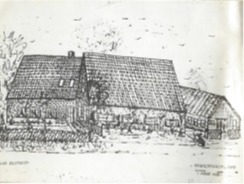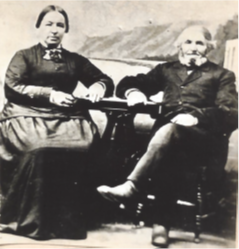Steve VanderVeen: Berend Scholten grows crops in Graafschap

Berend Hendrik Scholten was a pioneer farmer. Like many of his neighbors in Graafschap, he grew crops. But he also invested in cows. A century later, his family carried on that tradition as operators of a well-known community dairy.
He was born Berend Hendrik Wolbert in 1819, the youngest son of Lambertus Wolbert (1765-1835), a dairy farmer, and Hille Scholten. His father, upon marrying Hille, not only inherited the Scholte farm in Haftenkamp, Graafschap (county) of Bentheim, Germany, but also took her family name.
When Berend was 25 years old, the potato famine forced 70 community members, including Riekus Johannes and Zwaantje Diekovers Bouws, to follow Albertus Van Raalte’s lead and leave for America. Berend followed two years later.
Van Raalte and his immediate followers left Rotterdam in the fall of 1846 aboard the Southerner. The emigrants from Bentheim left Rotterdam aboard the Antoinette Marie on April 4, 1847. They arrived in New York on May 23.
From there, they took a steamship to Albany and a flatboat on the Erie Canal. Next, they sailed on Lake Erie, Lake Huron, the Mackinac Straits, and Lake Michigan before landing on the beach near the outlet of Black Lake (Macatawa) on June 20, 1847.

With the help of Jan Rabbers, the group’s leaders followed the Odawa-forged trails to scout the forest. They chose a hilltop three miles south of the Holland colony and called it Graafschap. So eager were they to build their log shanties, they began felling trees on unsurveyed and untitled land. Eventually they purchased that land, which the government had taken through treaty, at $1.25 per acre.
Thus, by the time Berend Hendrick Scholten arrived in June 1849, his acquaintances had already established farms around the hill. He acquired land several miles to the southwest next to another hill and a small creek, which he later named Rivulet (“small creek”) Hurst (“hill”).
By 1873, he'd purchased 120 acres from the U.S. government and private citizens, for which he paid $1.25-$1.50 per acre.
Like his neighbors, Berend Hendrik began clearing land before he had the legal title or skill to do so. Chopping trees and building a shanty wasn't a one-man job, and dangerous. Fortunately, Berend had help from a friend, Jan Harm Slenk, who'd emigrated with him. (A few years later, Slenk bought 80 acres to the east of the Scholten property.)
The existence of stumps and roots and wild animals, however, made planting and growing crops inefficient. Among the stumps, Berend had planted corn and potatoes, preparing the ground with a hoe, the only cultivating tool he had. For meat, he and the settlers had chickens and pigs. For rodent control, they had cats. Thus, the harvest in 1849-1850 was small.
Because they couldn’t grow enough food for themselves and lacked cash to buy supplies, the settlers had to hire themselves out to others. Many young men worked on farms around Kalamazoo and Plainwell. This provided them with cash and taught them English language and farming skills.
With the cash, they bought supplies from merchants in Singapore to the west or Richmond to the east. But doing so meant they might have to carry 60-pound sacks of flour or potatoes for miles on their back.
Subscribe: Get unlimited access to our local coverage
So clearing their own land to grow food took even longer, and longer still if there were injuries. Coming from a land with few trees meant they didn’t know how to properly use an ax or a two-man crosscut pull saw. But they learned.
In 1852, 35-year-old Berend married 19-year old Hendrika Lucas, the daughter of an 1847 Graafschap pioneer. Hendrika taught English to the immigrant community.

Getting married encouraged Berend to abandon his shanty and build a log cabin, one with three rooms (kitchen, living room and master bedroom) on the ground floor and an attic on the second level, which he and Hendrika converted into bedrooms when they had children.
Their cabin also had a fieldstone fireplace with a large stone chimney outside. Their barn was a log structure, but larger and taller than the house. For wood, Berend and Jan felled a pine tree that was six feet in diameter. Although the roots resisted decay for many years, the tree itself provided shingles for Scholten’s new barn and house.
Then in 1871, all was destroyed.
— Steve VanderVeen is a resident of Holland. You may reach him at skvveen@gmail.com. His book, "The Holland Area's First Entrepreneurs," is available at Reader’s World.
This article originally appeared on The Holland Sentinel: Holland History: Berend Scholten grows crops in Graafschap
